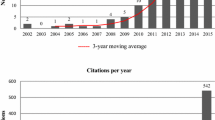Abstract
Households save income for various reasons, including the need to plan for the future, the intention to leave a bequest, and the desire to guard against unforeseen expenditures and income fluctuations. Although it is widely believed that prudent individuals engage in precautionary saving, the extent of such saving is not well understood. This paper develops a model of saving with an explicit role for the Leland-Kimball measure of prudence. Estimation of the model using household-level data from Italy suggests an average value of relative prudence near 4 or 5, with approximately 15 to 36 percent of total saving being precautionary.
Similar content being viewed by others
References
Abel, A. B. and M. Warshawsky. 1988. “Specification of the Joy of Giving: Insights from Altruism.”Review of Economics and Statistics 70: 145–149.
Alessi, R. and A. Kapteyn. 2001. “Savings and Pensions in the Netherlands”Research in Economics 55: 61–82.
Arrow, K. J. 1965.Aspects of the Theory of Risk Bearing. Helsinki: Yrjo Jahnsson Lectures.
Bernheim, B. D. 1991. “How Strong are Bequest Motives? Evidence Based on Estimates of the Demand for Life Insurance and Annuities.”Journal of Political Economy 99: 899–927.
Browning, M. and A. Lusardi. 1996. “Household Saving: Micro Theories and Macro Facts.”Journal of Economic Literature 34: 1797–1855.
Caballero, R. J. 1991. “Earnings Uncertainty and Aggregate Wealth Accumulation.”American Economic Review 81: 859–871.
Campbell, J. Y., J. F. Cocco, F. J. Gomes, and P.J. Maenhout. 1999. “Investing Retirement Wealth: A Life-Cycle Model.” NBER Working Paper 7029.
Carroll, C. D. and A. A. Samwick. 1998. “How Important Is Precautionary Saving?”Review of Economics and Statistics 80: 410–419.
Dardanoni, V. 1991. “Precautionary Savings under Income Uncertainty: A Cross-Sectional Analysis.”Applied Economics 23: 153–160.
Deaton, A. 1992.Understanding Consumption. Oxford: Clarendon Press.
Dynan, K. E. 1993. “How Prudent are Consumers?”Journal of Political Economy 101: 1104–1113.
Eisenhauer, J. G. 2000. “Estimating Prudence.”Eastern Economic Journal 26: 379–392.
Eisenhauer, J. G. and L. Ventura. 2003. “Survey Measures of Risk Aversion and Prudence.”Applied Economics 35: 1477–1484.
Friedman, B. M. and M. Warshawsky. 1988. “Annuity Prices and Saving Behavior in the United States.” inPensions in the U. S. Economy, edited by Zvi Bodie, John B. Shoven, and David A. Wise. Chicago: University of Chicago Press.
Friedman, B. M. and M. J. Warshawsky. 1990. “The Cost of Annuities: Implications for Saving Behavior and Bequests”Quarterly Journal of Economics 105: 135–154.
Grossberg, A. 1991. “Personal Saving under Income Uncertainty: A Test of the Intertemporal Substitution Hypothesis.”Eastern Economic Journal 17: 203–210.
Guiso, L., T. Jappelli, and D. Terlizzese. 1992. “Earnings Uncertainty and Precautionary Saving.”Journal of Monetary Economics 30: 307–337.
Harrison, G.W. 2005. “Hypothetical Bias over Uncertain Outcomes.” University of Central Florida Economics Working Paper 05-04, March.
Hochguertel, S. 2003. “Precautionary Motives and Portfolio Decisions.”Journal of Applied Econometrics 18: 61–77.
Irvine, I. and S. Wang 2001. “Saving Behavior and Wealth Accumulation in a Pure Lifecycle Model with Income Uncertainty.”European Economic Review 45: 233–258.
Johansson-Stenman, O. and H. Svedsater. 2003. “Self-Image and Choice Experiments: Hypothetical and Actual Willingness to Pay.” Goteborg University Working Paper in Economics 94, March.
Kazarosian, M. 1997. “Precautionary Savings—A Panel Study.”Review of Economics and Statistics 79: 241–247.
Kimball, M.S. 1990a. “Precautionary Saving in the Small and in the Large.”Econometrica 58: 53–73.
Kimball, M.S. 1990b. “Precautionary Saving and the Marginal Propensity to Consume.” NBER Working Paper 3403.
Kuehlwein, M. 1991. “A Test for the Presence of Precautionary Saving.”Economics Letters 37: 471–475.
Kuehlwein, M. 1993. “Life-cycle and Altruistic Theories of Saving with Lifetime Uncertainty.”Review of Economics and Statistics 75: 38–47.
Leland, H. E. 1968. “Saving and Uncertainty: The Precautionary Demand for Saving.”Quarterly Journal of Economics 82: 465–473.
Little, J. and R. Berrens. 2004. “Explaining Disparities between Actual and Hypothetical Stated Values: Further Investigation using Meta-Analysis.”Economics Bulletin 3: 1–13.
Lusardi, A. 1997. “Precautionary Saving and Subjective Earnings Variance.”Economics Letters 57: 319–326.
Lusardi, A. 1998. “On the Importance of the Precautionary Saving Motive.”American Economic Review, Papers and Proceedings 88: 449–453.
Merrigan, P. and M. Normandin. 1996. “Precautionary Saving Motives: An Assessment from UK Time Series of Cross-Sections.”Economic Journal 106: 1193–1208.
Murphy, J. J. and T. H. Stevens. 2004. “Contingent Valuation, Hypothetical Bias, and Experimental Economics.”Agricultural and Resource Economics Review 33: 182–192.
Parker, J. A. 1999. “The Reaction of Household Consumption to Predictable Changes in Social Security Taxes.”American Economic Review 89: 959–973.
Pratt, J. W. 1964. “Risk Aversion in the Small and in the Large.”Econometrica 32: 122–136.
Skinner, J. 1988. “Risky Income, Life Cycle Consumption, and Precautionary Savings.”Journal of Monetary Economics 22: 237–255.
Starr-McCluer, M. 1996. “Health Insurance and Precautionary Savings.”American Economic Review 86: 285–295.
Ventura, L. and J. G. Eisenhauer. 2005. “The Relevance of Precautionary Saving.”German Economic Review 6: 23–35.
Verbeek, M. 2000.A Guide to Modern Econometrics. NY: John Wiley and Sons.
Viceira, L. M. 2001. “Optimal Portfolio Choice for Long-Horizon Investors with Nontradable Labor Income Risk.”Journal of Finance 56: 433–470.
Wang, X. 2001. “Income Risk and Portfolio Choice: An Empirical Study.” Mimeo, Ohio State University. http://www.panagora.com/research/2001cromwell/2001cp_58.pdf
Zeldes, S.P. 1989. “Optimal Consumption with Stochastic Income: Deviations from Certainty Equivalence.”Quarterly Journal of Economics 104: 275–298.
Author information
Authors and Affiliations
Additional information
The authors are grateful to an anonymous referee for helpful comments.
Rights and permissions
About this article
Cite this article
Ventura, L., Eisenhauer, J.G. Prudence and precautionary saving. J Econ Finan 30, 155–168 (2006). https://doi.org/10.1007/BF02761482
Issue Date:
DOI: https://doi.org/10.1007/BF02761482




